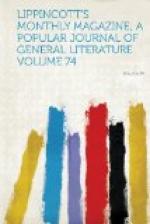They eat up everything in the kitchen-garden, devour
every leaf off my peach and orange trees, scarring
and spoiling the fruit as well. It is no comfort
whatever that they are wonderfully beautiful creatures,
striped and ringed with a thousand colors in a thousand
various ways: one has only to see the riddled
appearance of every leaf and flower to harden one’s
heart. Just now they have cleared off every blossom
out of the garden except my zinnias, which grow magnificently
and make the devastated flower-bed still gay with every
hue and tint a zinnia can put on—salmon-color,
rose, scarlet, pink, maroon, and fifty shades besides.
On the veldt too the flowers have passed by, but their
place is taken by the grasses, which are all in seed.
People say the grass is rank and poor, and of not
much account as food for stock, but it has an astonishing
variety of beautiful seeds. In one patch it is
like miniature pampas-grass, only a couple of inches
long each seed-pod, but white and fluffy. Again,
there will be tall stems laden with rich purple grains
or delicate tufts of rose-colored seed. One of
the prettiest, however, is like wee green harebells
hanging all down a tall and slender stalk, and hiding
within their cups the seed. Unfortunately, the
weeds and burs seed just as freely, and there is one
especial torment to the garden in the shape of an
innocent-looking little plant something like an alpine
strawberry in leaf and blossom, bearing a most aggravating
tuft of little black spines which lose no opportunity
of sticking to one’s petticoats in myriads.
They are familiarly known as “blackjacks,”
and can hold their own as pests with any weed of my
acquaintance.
But the most beautiful tree I have seen in Natal was
an Acacia flamboyante. I saw it at D’Urban,
and I shall never forget the contrast of its vivid
green, bright as the spring foliage of a young oak,
and the crown of rich crimson flowers on its topmost
branches, tossing their brilliant blossoms against
a background of gleaming sea and sky. It was
really splendid, like a bit of Italian coloring among
the sombre tangle of tropical verdure. It is
too cold up here for this glorious tree, which properly
belongs to a far more tropical temperature than even
D’Urban can mount up to.
I am looking forward to next month and the following
ones to make some little excursions into the country,
or to go “trekking,” as the local expression
is. I hear on all sides how much that is interesting
lies a little way beyond the reach of a ride, but
it is difficult for the mistress—who is
at the same time the general servant—of
an establishment out here to get away from home for
even a few days, especially when there is a couple
of small children to be left behind. No one travels
now who can possibly help it, for the sudden violent
rains which come down nearly every afternoon swell
the rivers and make even the spruits impassable; so
a traveler may be detained for days within a few miles
of his destination. Now, in winter the roads will
be hard, and dust will be the only inconvenience.
At least, that is what I am promised.




